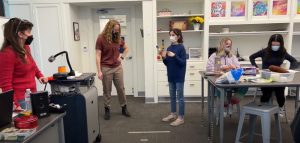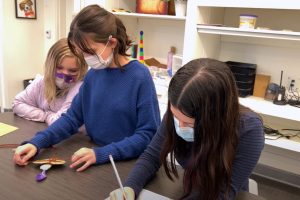“I want to be a biologist because I’m really interested in animals and plants,” says Ariel, a fourth-grade student at Skamania Grade School.
Ashlyn, also a fourth-grade student at Skamania Grade School, said she was excited about engineering.
Through nPower Girls, young female students in Southwest Washington like Ariel and Ashlyn gain STEM skills by participating in hands-on learning and mentorship. They also engage in the High School and Beyond Plan career exploration process. nPower Girls – a partnership between Career Connect Southwest, school districts in southwest Washington, and many community partners – provides much-needed STEM career connected learning opportunities for students.

For Vickei Hrdina, the Director of Career Readiness & STEM Initiatives at ESD 112, nPower Girls is a passion project. Hrdina previously worked as a middle school STEM teacher and observed many young women fall into gender-based roles and not want to pursue STEM. Before teaching, Hrdina was an archaeologist and was the only woman in most of her projects.
“I started to see a place where we could do some great quality work with teachers to change the ways we structure learning experiences in our classrooms,” Hrdina said.
nPower Girls began in 2015 as a math and science program funded by a three-year Department of Education research grant. STEM summer camps provided activities for students as well as professional development opportunities for teachers.
Today, nPower Girls has expanded to a virtual mentoring program that began in 2020 and allows students the opportunity to explore STEM careers and solve real-world problems. Students are introduced to female mentors working locally in STEM-related fields such as as chemistry, energy, and engineering.
Students are recruited to participate through a community-based approach that focuses on racial equity. ESD 112 works with principals and middle school science and math teachers within the region’s districts to encourage participation from Latinx girls, particularly from migrant families, English-language learning students, and Native American students. Recruitment strategies include ensuring that students see themselves reflected in the mentors and working with community-based organizations to reach targeted communities.
Discovering STEM careers through mentorship
 nPower Girls hosts monthly after-school virtual mentoring sessions for students from seven rural school districts. Each session is led by a woman working in a STEM-related profession in the local community, who shares a problem they are trying to understand in their field. Students then work with their mentor and share their findings with other students and families.
nPower Girls hosts monthly after-school virtual mentoring sessions for students from seven rural school districts. Each session is led by a woman working in a STEM-related profession in the local community, who shares a problem they are trying to understand in their field. Students then work with their mentor and share their findings with other students and families.
“I want to hear them talk about the problem and different ways to solve it and have a healthy argument,” Hrdina says. “It’s my job to translate their real-world problems to what my middle school students would be able to do.”
For one mentor, a drone engineer, the problem was keeping condensation out of the camera lens, especially at higher altitudes. This became a challenge that involved experimenting with methods for preventing and eliminating humidity. One student suggested using the same approaches to dehumidifying eyeglasses when wearing masks: applying topical agents, creating better seals, or adapting a version of a car windshield dehumidifier to defog the drone lens.
Exploring solutions to real challenges that local businesses face exposes students to high-wage, family-sustaining STEM-related jobs in their communities, allowing them to discover possible career paths they might want to pursue. Activities like this prepare students for high school and the next steps in their education, as well as the High School and Beyond Planning process that begins in middle school.
At the beginning of the year, students participating in nPower Girls are asked to visit career exploration websites, then sketch or build a model of their dream job. Students recently expressed an interest in veterinary science, which led Hrdina to bring in a vet tech and vet assistant to a mentorship session. Another example of how participants’ interests lead to specific learning opportunities was when a student interested in map making led to a “Walking Your Land” lesson that incorporated the Native perspective.
“I feel like we can tie nPower Girls to an opportunity for young women to explore STEM careers before they get to the High School and Beyond Plan,” Hrdina says. “We have to get more exposure to all kids about all postsecondary career options.”